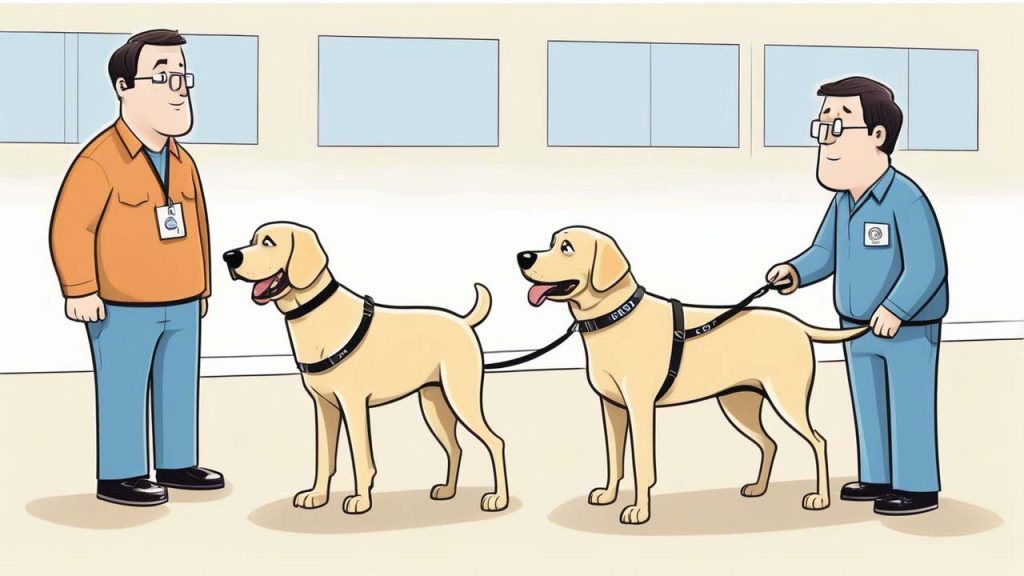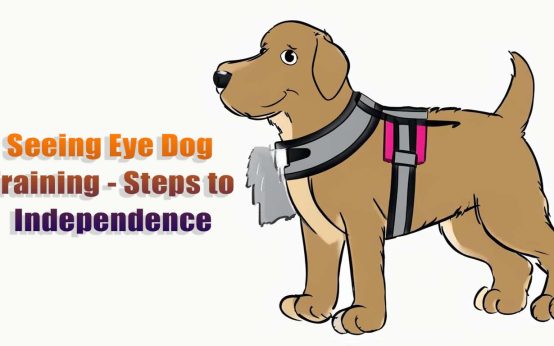Seeing eye dogs provide independence, safety, and companionship for individuals who are visually impaired, guiding them through their daily lives with confidence and support. But what does it take to train a seeing eye dog? These incredible dogs go through a rigorous training process, starting from early socialization to learning complex skills and commands. Seeing eye dog training combines dedication, expertise, and a strong bond between dog and handler to create a reliable partnership.
This guide offers a look into the journey of seeing eye dog training, from the initial stages to advanced training techniques, providing insight into the effort and dedication behind this life-changing work.
What is Seeing Eye Dog Training?
Seeing eye dog training is a specialized program that prepares dogs to become guides for people who are blind or visually impaired. The training is intense and requires a focus on specific skills, such as obstacle avoidance, intelligent disobedience, and command following, which all help the handler navigate the world safely.
1. A Guide to Independence
Seeing eye dogs are not just pets; they are essential tools for independence. They help handlers move safely through various environments, navigate obstacles, and travel with confidence, whether it’s crossing a busy street or entering new spaces.
2. Life-Changing Companionship
Beyond guidance, seeing eye dogs offer companionship and support, creating a meaningful bond. This partnership extends beyond functional tasks, providing emotional support and a deep sense of companionship.

The Journey of Seeing Eye Dog Training
The process to become a seeing eye dog is demanding, beginning with basic socialization and advancing to specialized training. Only dogs with the right temperament and dedication reach the final stages, making each seeing eye dog a symbol of resilience and skill.
1. Puppy Socialization
The journey begins with puppy socialization, where future guide dogs live with volunteer puppy raisers. During this stage, puppies are introduced to various environments, sounds, and experiences to help them build confidence.
- Basic Obedience: Puppies learn foundational commands like “sit,” “stay,” and “come,” preparing them for future advanced training.
- Exposure to Diverse Environments: Puppy raisers expose them to parks, busy streets, and even public transportation, giving them the adaptability needed for later work.
2. Formal Guide Training
After socialization, dogs begin formal training around 14-18 months. This is where they learn specific guiding tasks that will make them reliable seeing eye dogs.
- Obstacle Avoidance: Dogs learn to spot obstacles, such as low-hanging branches, curbs, and other potential hazards, and guide their handler around them.
- Intelligent Disobedience: A unique skill, intelligent disobedience allows a guide dog to ignore a command if it would lead the handler into danger. For instance, if a handler instructs the dog to cross a street but a car is approaching, the dog will refuse, keeping both of them safe.
- Navigational Commands: Dogs learn directional commands such as “left,” “right,” and “forward,” guiding their handler to intended destinations.
3. Team Matching and Training
Once a dog has completed formal training, the organization carefully pairs them with a handler based on factors such as lifestyle, pace, and specific needs.
- Bonding Sessions: New handlers spend time bonding with their dog, learning each other’s communication styles and building trust.
- Team Training: Handlers learn how to use verbal commands, understand their dog’s cues, and give guidance. This phase solidifies the partnership, ensuring both are comfortable and confident working together.
Key Skills Taught in Seeing Eye Dog Training
The training curriculum for seeing eye dogs covers a range of skills, each designed to provide safe and efficient guidance. Here are some of the most important skills:
1. Advanced Obedience
Seeing eye dogs learn advanced obedience skills to ensure they respond promptly to commands in any situation, whether they’re in a quiet room or a busy urban environment.
- Focus in Public Settings: Training focuses on helping dogs ignore distractions, from other animals to loud noises, allowing them to stay focused on their task.
- Recall and Response: Dogs must respond to commands reliably, providing consistent support when navigating changing environments.
2. Crowd and Obstacle Navigation
A seeing eye dog’s ability to guide through crowded areas and avoid obstacles is essential for safety. They learn to:
- Move Through Crowds: Guide dogs are trained to weave through crowded areas, making sure their handler doesn’t bump into others.
- Identify and Avoid Hazards: From steps and curbs to low objects, dogs learn to identify and guide their handler around obstacles safely.
3. Street Crossing and Intelligent Disobedience
Crossing streets is one of the most challenging and critical skills. Guide dogs are trained to stop at curbs, assess moving traffic, and cross safely.
- Intelligent Disobedience: Dogs must sometimes disobey commands if they sense danger, which is a unique aspect of guide training. This helps protect both dog and handler from harm.
Choosing the Right Breeds for Seeing Eye Dogs
Some dog breeds have the temperament, intelligence, and physical characteristics ideal for guide work. Here are a few of the most common breeds:
1. Labrador Retrievers
Labradors are known for their calm demeanor, intelligence, and eagerness to please, making them excellent guide dogs. They adapt well to various environments and form strong bonds with their handlers.
2. Golden Retrievers
Golden Retrievers have gentle temperaments and natural intuition, which helps them excel in tasks that require patience and alertness.
3. German Shepherds
German Shepherds are focused, disciplined, and highly trainable, making them reliable guide dogs, particularly in more complex environments.
The Role of Seeing Eye Dog Handlers
Handlers are more than just recipients of a guide dog; they are active participants in the partnership. The bond they form with their dog is built on trust, communication, and respect.
1. Building Trust and Communication
Trust is essential for a successful handler-guide dog relationship. Handlers learn to read their dog’s cues and adjust to the dog’s guiding techniques.
- Consistency in Commands: Handlers must use consistent commands to prevent confusion and strengthen communication.
- Positive Reinforcement: Praising the dog for good behavior reinforces the training, helping maintain skills over time.
2. Maintaining Skills
Handlers play a significant role in keeping their guide dog’s skills sharp. Regular practice ensures the dog remains responsive to commands and confident in their abilities.
- Ongoing Practice: Regular training sessions and varied routes help maintain the dog’s guiding skills.
- Health and Well-Being: Keeping the dog physically healthy and mentally stimulated is essential to their ongoing performance and happiness.
FAQs About Seeing Eye Dog Training
How long does it take to train a seeing eye dog?
- Training typically takes 18-24 months, including both early socialization and formal guide training.
What happens if a dog doesn’t complete the program?
- Dogs that don’t complete training are often placed in loving homes as pets or service dogs for other roles.
Can any breed become a seeing eye dog?
- While some breeds excel in guide dog work, like Labradors and Golden Retrievers, the dog’s temperament and adaptability are also crucial.
How are handlers chosen for each dog?
- Handlers are carefully matched based on lifestyle, walking speed, and personal needs, ensuring compatibility and safety.
How much does a seeing eye dog cost?
- Training a seeing eye dog can cost over $50,000, but many organizations provide dogs to individuals at little or no cost through donations and fundraising.



 Seeing Eye Dog Training – Steps to Independence
Seeing Eye Dog Training – Steps to Independence